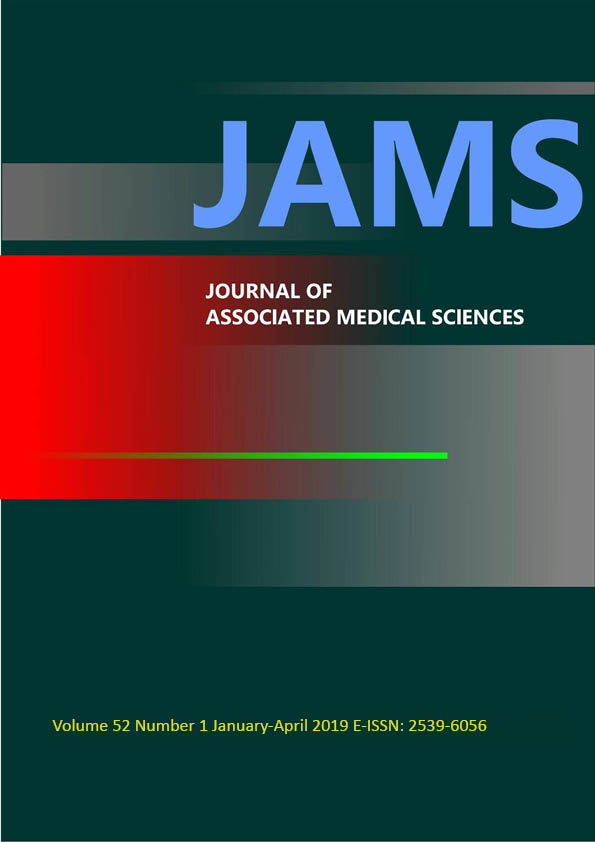Effects of crude medicinal Thai flower extracts on cytotoxicity and FMS-like tyrosine kinase 3 protein expression in EoL-1 leukemic cell line
Main Article Content
Abstract
Background: Leukemia is one cause of death worldwide. Nowadays, natural therapies such as the use of medicinal plants may reduce adverse side effects of leukemia. Accordingly, the anticancer properties of medicinal plants have been recognized for centuries. This study focuses on Thai flowers from traditional drug recipes including phikun (Mimusops elengi Linn.), boonark (Mesua ferrea Linn.), ketawa (Gardenia jasminoides J.Ellis), and sarapi (Mammea siamensis (Miq.) T. Anders) for cytotoxicity and leukemia suppression. Fms-like tyrosine kinase 3 (FLT3) is a prognostic marker for acute myeloblastic leukemia (AML) and leukemic cell proliferation. Thus, FLT3 is a reliable marker for minimal residual disease (MRD) assessment in leukemia patients.
Objectives: To investigate the cytotoxicity of crude ethanolic extracts from four Thai flowers and to determine their effects on FLT3 protein expression in EoL-1 cells.
Materials and methods: Phikun, boonark, ketawa, and sarapi flowers were extracted by using 95% ethanol. An MTT assay was performed to evaluate cytotoxicity of each crude ethanolic flower extract. The effective crude ethanolic flower extract was further determined its inhibitory effect on FLT3 protein expression by Western blot analysis. Total cell number was determined by the trypan blue exclusion method.
Results: Crude ethanolic flower extracts from boonark demonstrated the strongest cytotoxic activity with the inhibitory concentration at 50% (IC50) values of 62.5±3.9 ug/mL. Moreover, it could decrease the total cell number and FLT3 protein expression by a time- and dose-dependent manner.
Conclusion: The crude ethanolic flower extracts from boonark inhibited cell proliferation via the suppression of FLT3 expression. It could be suggested that crude ethanolic flower extract from boonark flower is a promising approach for new anti-leukemic drug candidates.
Article Details

This work is licensed under a Creative Commons Attribution-NonCommercial-NoDerivatives 4.0 International License.
Personal views expressed by the contributors in their articles are not necessarily those of the Journal of Associated Medical Sciences, Faculty of Associated Medical Sciences, Chiang Mai University.
References
[2] Sakamoto Y, Mariya Y, Sasaki S, Teshiromori R, Oshikiri T, Segawa M, et al. WT1 mRNA Level in Peripheral Blood Is a Sensitive Biomarker for Monitoring Minimal Residual Disease in Acute Myeloid Leukemia. Tohoku J Exp Med 2009; 219(2): 169-76.
[3] Choudhary C, Muller-Tidow C, Berdel WE, Serve H. Signal transduction of oncogenic Flt3. Int J Hematol 2005; 82(2): 93-9.
[4] Chu SH, Small D. Mechanisms of resistance to FLT3 inhibitors. Drug Resistance Updates 2009; 12(1-2): 8-16.
[5] Choudhary C, Schwable J, Brandts C, Tickenbrock L, Sargin B, Kindler T, et al. AML-associated Flt3 kinase domain mutations show signal transduction differences compared with Flt3 ITD mutations. Blood 2005; 106(1): 265-73.
[6] Zheng R, Levis M, Piloto O, Brown P, Baldwin BR, Gorin NC, et al. FLT3 ligand causes autocrine signaling in acute myeloid leukemia cells. Blood 2004; 103(1): 267-74.
[7] Lee CC, Houghton P. Cytotoxicity of plants from Malaysia and Thailand used traditionally to treat cancer. J Ethnopharmacol 2005; 100(3): 237-43.
[8] Alakh S, Hemalatha S, Sairam K. Phytopharmacological review of Mesua ferrea Linn. International Journal of Phytopharmacology 2014; 5(1): 6-14.
[9] Cheeptham N, Towers GHN. Light-mediated activities of some Thai medicinal plant teas. Fitoterapia 2002; 73(7-8): 651-62.
[10] Gami B, Pathak S, Parabia M. Ethnobotanical, phytochemical and pharmacological review of Mimusops elengi Linn. Asian Pacific Journal of Tropical Biomedicine 2012; 2(9): 743-8.
[11] Chahar MK, DS SK, Geetha L, Lokesh T, Manohara K. Mesua ferrea L.: a review of the medical evidence for its phytochemistry and pharmacological actions. African Journal of Pharmacy and Pharmacology 2013; 7(6): 211-9.
[12] Sangkaruk R, Tima S, Rungrojsakul M, Chiampanichayakul S, Anuchapreeda S. Effects of Saraphi (Mammea siamensis) flower extracts on cell proliferation and Fms-like tyrosine kinase 3 expression in leukemic EoL-1 cell line. Journal of Associated Medical Sciences 2016; 49(2): 286-93.
[13] Chaichana J, Niwatananum W, Vejabhikul S, Somna S, Chansakaow S. Volatile constituents and biological activities of Gardenia jasminoides. J Health Res 2009; 23(3): 141-5.
[14] Grafone T, Palmisano M, Nicci C, Storti S. An overview on the role of FLT3-tyrosine kinase receptor in acute myeloid leukemia: biology and treatment. Oncology Reviews 2012; 6(1): e8.
[15] Weisberg E, Boulton C, Kelly LM, Manley P, Fabbro D, Meyer T, et al. Inhibition of mutant FLT3 receptors in leukemia cells by the small molecule tyrosine kinase inhibitor PKC412. Cancer Cell 2002; 1(5): 433-43.
[16] Zarrinkar PP, Gunawardane RN, Cramer MD, Gardner MF, Brigham D, Belli B, et al. AC220 is a uniquely potent and selective inhibitor of FLT3 for the treatment of acute myeloid leukemia (AML). Blood 2009; 114(14): 2984-92.
[17] Fathi AT, Arowojolu O, Swinnen I, Sato T, Rajkhowa T, Small D, et al. A potential therapeutic target for FLT3-ITD AML: PIM1 kinase. Leukemia Res 2012; 36(2): 224-31.
[18] Saha S, Monroe A, Day MR. Growth, yield, plant quality and nutrition of basil (Ocimum basilicum L.) under soilless agricultural systems. Annals of Agricultural Sciences 2016; 61(2): 181-6.
[19] Ncube B, Finnie J, Van Staden J. Quality from the field: the impact of environmental factors as quality determinants in medicinal plants. South African Journal of Botany 2012; 82: 11-20.
[20] Sharma A, Sharma S, Parashar B. Mesua ferrae linn:-A Review of the Indian Medical Herb. Systematic Reviews in Pharmacy 2017; 8(1): 19.
[21] Nordin K, Ahmad F, Taufiq-Yap Y, Ali AM. Volatile Components of Methanol Extract from the Flower of Malaysian Musea Ferrea Linn. Oriental Journal of Chemistry 2004; 20: 69-72.


